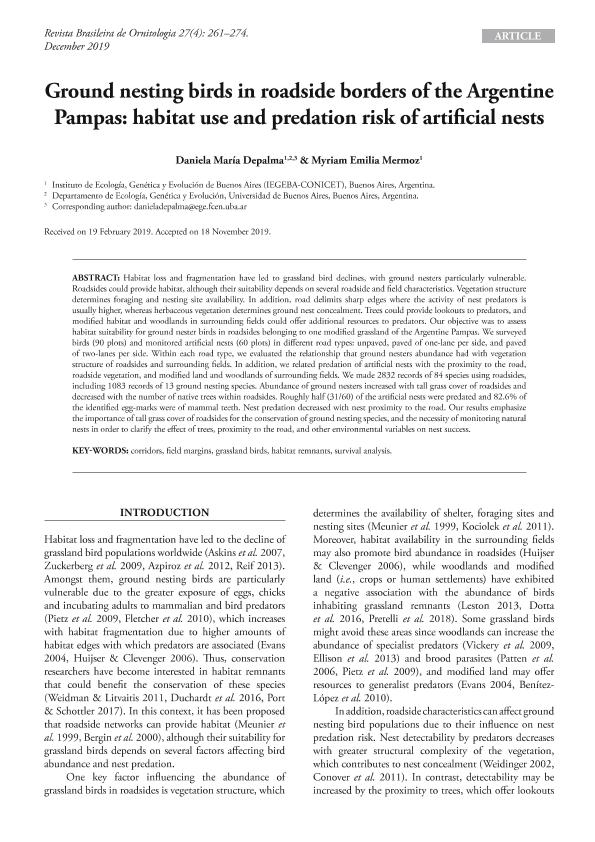Mostrar el registro sencillo del ítem
dc.contributor.author
Depalma, Daniela María

dc.contributor.author
Mermoz, Myriam Emilia

dc.date.available
2022-07-29T16:02:19Z
dc.date.issued
2019-12
dc.identifier.citation
Depalma, Daniela María; Mermoz, Myriam Emilia; Ground nesting birds in roadside borders of the Argentine Pampas: habitat use and predation risk of artificial nests; Sociedade Brasileira de Ornitologia; Ararajuba; 27; 12-2019; 258-271
dc.identifier.issn
0103-5657
dc.identifier.uri
http://hdl.handle.net/11336/163550
dc.description.abstract
Habitat loss and fragmentation have led to grassland bird declines, with ground nesters particularly vulnerable. Roadsides could provide habitat, although their suitability depends on several roadside and field characteristics. Vegetation structure determines foraging and nesting site availability. In addition, road delimits sharp edges where the activity of nest predators is usually higher, whereas herbaceous vegetation determines ground nest concealment. Trees could provide lookouts to predators, and modified habitat and woodlands in surrounding fields could offer predators additional resources. Our objective was to assess habitat suitability for ground nesters in roadsides belonging to one modified grassland of the Argentine Pampas. We surveyed birds (90 plots) and monitored artificial nests (60 plots) in different road types: unpaved, paved of one-lane per side, and paved of two-lanes per side. Within each road type, we evaluated the relationship that ground nesters abundance had with vegetation structure of roadsides and surrounding fields. In addition, we related predation of artificial nests with the proximity to the road, roadside vegetation, and modified land and woodlands of surrounding fields. We made 2832 records of 84 species using roadsides, including 1083 records of 13 ground nesting species. Abundance of ground nesters increased with tall grass cover of roadsides and decreased with the number of native trees within roadsides. Roughly half (31/60) of the artificial nests were predated and 82.6 % of the identified egg-marks were of mammal teeth. Nest predation decreased with nest proximity to the road. Our results emphasize the importance of tall grass cover of roadsides for the conservation of ground nesting species, and the necessity of monitoring natural nests in order to clarify the effect of trees, proximity to the road, and other environmental variables on nest success.
dc.format
application/pdf
dc.language.iso
eng
dc.publisher
Sociedade Brasileira de Ornitologia

dc.rights
info:eu-repo/semantics/openAccess
dc.rights.uri
https://creativecommons.org/licenses/by-nc-sa/2.5/ar/
dc.subject
corridors
dc.subject
field margins
dc.subject
grassland birds
dc.subject
habitat remnants
dc.subject.classification
Zoología, Ornitología, Entomología, Etología

dc.subject.classification
Ciencias Biológicas

dc.subject.classification
CIENCIAS NATURALES Y EXACTAS

dc.title
Ground nesting birds in roadside borders of the Argentine Pampas: habitat use and predation risk of artificial nests
dc.type
info:eu-repo/semantics/article
dc.type
info:ar-repo/semantics/artículo
dc.type
info:eu-repo/semantics/publishedVersion
dc.date.updated
2020-11-20T14:44:35Z
dc.journal.volume
27
dc.journal.pagination
258-271
dc.journal.pais
Brasil

dc.description.fil
Fil: Depalma, Daniela María. Consejo Nacional de Investigaciones Científicas y Técnicas. Oficina de Coordinación Administrativa Ciudad Universitaria. Instituto de Ecología, Genética y Evolución de Buenos Aires. Universidad de Buenos Aires. Facultad de Ciencias Exactas y Naturales. Instituto de Ecología, Genética y Evolución de Buenos Aires; Argentina. Universidad de Buenos Aires. Facultad de Ciencias Exactas y Naturales. Departamento de Ecología, Genética y Evolución; Argentina
dc.description.fil
Fil: Mermoz, Myriam Emilia. Consejo Nacional de Investigaciones Científicas y Técnicas. Oficina de Coordinación Administrativa Ciudad Universitaria. Instituto de Ecología, Genética y Evolución de Buenos Aires. Universidad de Buenos Aires. Facultad de Ciencias Exactas y Naturales. Instituto de Ecología, Genética y Evolución de Buenos Aires; Argentina
dc.journal.title
Ararajuba

dc.relation.alternativeid
info:eu-repo/semantics/altIdentifier/url/https://link.springer.com/article/10.1007/BF03546072
dc.relation.alternativeid
info:eu-repo/semantics/altIdentifier/doi/http://dx.doi.org/10.1007/BF03546072
Archivos asociados
